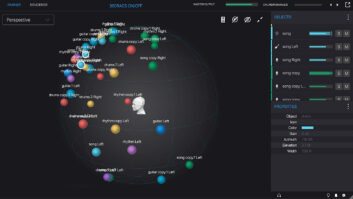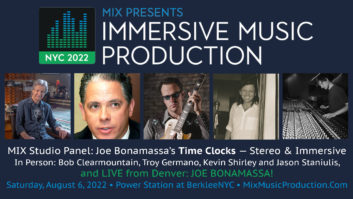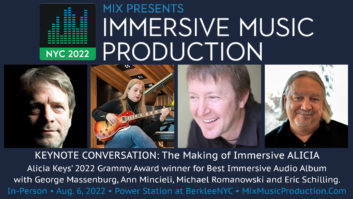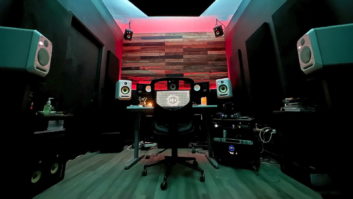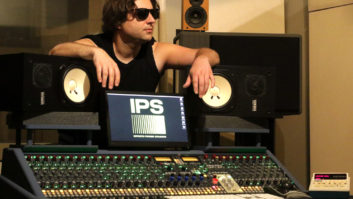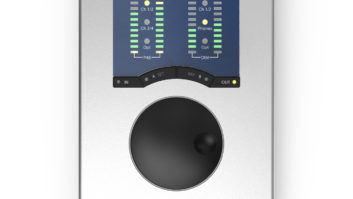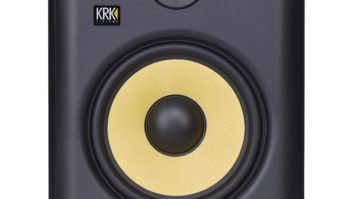On the afternoon of July 24, 2002, as he prepared to throw a party to celebrate the opening of Studios 6 and 7, Hit Factory CEO Troy Germano beamed with confidence. Despite the uncertain economic climate in which he found himself, Germano made a bold case for the rooms themselves and the consoles within them: twin Solid State Logic 80-input XL boards, the new state-of-the-art in analog and surround mixing.
Six months later, Germano’s optimism had been reinforced by the success of the rooms. In their first six months, Studios 6 and 7 have hosted a galaxy of recording superstars who have used them for their tracking, overdubbing, mixing and multichannel capabilities. Among the artists who have recorded basic tracks in Studios 6 and 7 are Sting, Guster, Luther Vandross, Eve, Missy Elliott and Japanese sensation Kenji Ozawa; Lenny Kravitz, Matchbox 20, Paul McCartney, Santana, LL Cool J and Toni Braxton have overdubbed and/or mixed in the new rooms; and one of Hit Factory’s longest-running clients, Paul Simon, tracked and mixed his contribution to The Wild Thornberrys soundtrack in Studio 6, which Germano says was modeled after the room at the old Hit Factory Broadway location that Simon had used since 1983.
“It’s been a really good mix of clients in both rooms, and they’ve used them for recording and mixing,” says Germano. “We take pride in the diversity of styles that we cater to: pop, hip hop, R&B, rock, jazz, cast albums, etc.”
Some clients, like Kravitz and McCartney, brought 5.1-channel DVD mixes into Studios 6 and 7, which are purpose-built for surround production. Other multichannel projects that were done recently at the Hit Factory include DVDs for Iron Maiden, the Foo Fighters and Elvis Presley.
Germano says, “We’re doing a lot more surround work than ever before. It’s exciting. It’s finally starting to happen as everybody predicted that it would.”
Always in the forefront of new technology, Germano was among the first studio owners to embrace the SSL XL platform, a refinement of the British manufacturer’s hugely successful J Series of SuperAnalogue consoles.
The transition from the J to the XL has been as smooth as Germano hoped for. “It really has been seamless,” he says. “Usually when you change a console, even if it’s from the same manufacturer, you wonder what you’re going to lose. But I haven’t heard one negative comment about the XL. People love the faster computer, and they think that the console sounds a little bit better.”
Soon after installing the two XLs in Studios 6 and 7, Germano purchased a third one for Studio 3 in the New York location.
“When we put XLs in Studios 6 and 7, we thought that if the consoles worked, we would add a third one in six months to a year,” he says. “But we’ve been so happy with the console that we ended up ordering a third one three months after opening the new rooms. Now we have three XLs and three Js in New York, plus a Euphonix System 5 [digital console].” (In the Hit Factory’s Miami location, the company has three SSL Js, a Sony Oxford digital board and a vintage Neve 8068.)
Hit Factory Studios 6 and 7 offer not only the most advanced analog consoles in the market, but top-notch recorders, monitors and outboard equipment, as well as peerless acoustics. Designed by Dave Bell from UK-based White Mark Ltd., in conjunction with Germano, the rooms are streamlined and comfortable, with clean, sleek lines and plenty of space.
Each room offers its own 48-channel Pro Tools MIXPlus system (as well as access to one of three Pro Tools|HD systems in-house); a Sony 3348 HR; two Studer A827s; and outboard racks tailored for surround mixing, with highlights including three stereo GML EQs, Sony 777 Sampling Reverbs, Avalon 737s and 2055s, Lexicon 960 Ls, and Empirical Labs Distressors and Fatsos. Each room is equipped with five soffit-mounted custom speakers designed by George Augspurger.
Germano, who half-jokingly compares the studio industry to the hotel business, says that his equipment and design choices reflect the needs of his clientele. “People come to us for these great analog consoles, the large monitors, the acoustics, the outboard gear and the services we provide,” says Germano. “More than ever, you have to give people value for their money, whether you’re a department store, a candy store or a recording studio. We want people to walk away feeling that they were treated right and provided with a good environment in which to be creative. We want them to feel that their money was well spent.”
